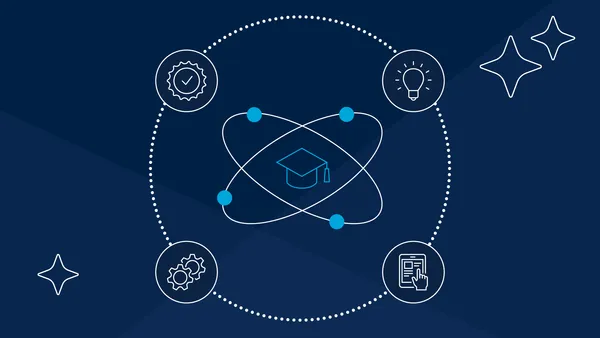With enrollment sliding and statewide population trends promising to compound those troubles, the University of Maine System knew it needed a way to get more students through the door.
From 2007 to 2017 alone, enrollment in its universities fell 15%. But it has since found a way to reverse that trend: recruiting nontraditional students, particularly those who want to attend college online. To do so, Maine has retooled its approach to adult learners, said Robert Placido, the system's associate vice chancellor of academic affairs.
Early results indicate it's working. Enrollment across the system was up 1.5% year-over-year this spring, and as of last fall, it led in growth among New England's public four-year higher education systems.
"We have folks who just can't come to campuses," Placido said. "Even if you're five miles away, if you're a single parent juggling other jobs, you don't really have a bridge to further your education unless there is something that offers flexibility, and online [learning] is that space for them."
In the U of Maine System, 36% of students were part-time this past spring, a one-point jump over the prior year. Meanwhile, online credit hour growth is booming and now accounts for 24% of all credit hours taken. That's up more than 10% from just a year ago.
In many ways, Maine is an extreme example of the demographic trends at work across the country over the last decade. During the Great Recession, colleges and universities saw a bump in enrollment, as has been the case in prior downturns. But those flocking to school were doing so largely to gain new skills quickly, and the change in undergraduate enrollment during that time was concentrated in two-year colleges, according to a 2018 U.S. Census report on the topic.
Enrollment at two-year schools has since returned to pre-recession levels. And while enrollment at four-year colleges has dropped on average, it remains higher than in 2008.
However, due to slowing birthrates — something Maine is experiencing at a higher rate than most states — high school graduates are now a shrinking market for colleges. That is causing the schools that once relied on them heavily, particularly four-year institutions, to look to other prospective student groups to increase their numbers.
Complicating matters further is the prospect of another recession, which economists have forecast could happen soon, with the business cycle slowing.
Some higher ed analysts say the four-year schools that have made their programs more open and flexible, such as by offering them online, are in a better position than they were a decade ago to attract a wider range of students. That will be critical for those schools in the event of a downturn.
"They are being a bit more flexible in their programmatic structure to offer more accessibility," said Emily Wadhwani, a higher education analyst at Fitch Ratings. "In the next downturn, that should help to prevent erosion of those programs."
'It can be tough to grow'
By some estimates, the adult learner market is around 30 million people — more than the current college enrollment nationwide. While this potential is driving much of the recent change, the way many students are approaching higher education is changing in the on-demand, post-recession era, said Alex Bloom, associate director of research at consulting firm EAB.
"Even traditional-aged undergrads might pursue a bachelor's degree on a path today that might seem strange to someone 30, or even 10 years ago," he said. It's not uncommon for someone to "enroll at one university and take online courses for two or three semesters, pause for a semester to work for a bit, then reenroll," he added.
While four-year schools have traditionally made it difficult for students to bounce in and out of their educational experience, more and more are shifting their approach.
"For those institutions without a great plethora of programs that don't allow you to reach a critical mass of programs online, it can be tough to grow."

Emily Wadhwani
Higher education analyst, Fitch Ratings
But capturing the growing market of online learners is extremely competitive. A few dozen schools jumped in early and hold the lion's share of the market.
Arizona State University, for example, launched ASU Online in 2010 and has more than 175 online degree and certificate programs reaching more than 46,000 students globally, its president, Michael Crow, told the Brookings Institution in May. Those who have successfully entered the market more recently have invested in years of planning and research, higher ed analysts say.
"Don't underestimate the infrastructure that goes into this," said Megan Adams, practice manager and enrollment expert at EAB. "From the organizational structure to marketing expertise to design capabilities, there's a whole list of infrastructure investment that needs to be made in order to stand up an online program."
That includes investing in audio and video to create course content and hiring online learning specialists who can cater to the different expectations and timelines of part-time and distance learners. Often, schools partner with an outside firm to provide marketing and analytics for online recruitment. In many ways, investing in an online program requires creating a parallel university experience. And it's expensive.
"The administration is a sunk cost," said Fitch's Wadhwani. "For those institutions without a great plethora of programs that don't allow you to reach a critical mass of programs online, it can be tough to grow."
'Find the unmet need'
Enrollment at Maryville University, a private institution outside of St. Louis, has grown rapidly since it launched a distance learning program in 2012. The university's enrollment in 2018-19 surpassed 10,000 for the first time in its 147-year history. Online learners are driving that growth and now account for nearly 6,000 students, including some 1,400 new online students this fall.
To start the online program, the university took one of its strongest offerings — graduate nursing — and redesigned it for distance learning, said Katherine Louthan, dean of Maryville's School of Adult and Online Education.
Bringing it to life online included investing in and creating audio and visual content, visual quizzes and podcasts. It also meant making sure the program was keeping up with board nursing requirements in other states. And knowing that the approach to advertising to online learners was much less straightforward than the approach for high school students, Maryville partnered with Pearson to handle its marketing and analytics.
The total investment was "in the range of several million dollars," according to Maryville President Mark Lombardi. So far, it's paying off. Maryville hit its three-year online enrollment target during its first year, with 400 students online. It was a significant bump to its some 3,800 existing students. Since then, the university has expanded its online offerings to other graduate programs, including business, education and cybersecurity.
In 2018, it added undergraduate programs online to tap the market of adults who haven't finished college.
Of Maryville's nearly 6,000 online students, the majority — 4,380 — are enrolled in part-time graduate or doctoral programs, according to the university's latest enrollment summary. Another 1,210 students attend online undergraduate programs part- or full-time.
Helped along by strong growth in full-time online students, Maryville's online undergraduate population grew more from 2018 to 2019 than the larger campus-based undergraduate student body, which counted 2,828 students this year. It grew more than online graduate programs, too.
"Our approach has been to find the unmet need in the market and help learners find that opportunity," Louthan said. That growth hasn't necessarily come at the expense of on-campus enrollment, she added. While the number of adult learners in on-campus undergraduate programs declined as expected due to the addition of the online options, the university's overall on-campus undergraduate population has grown by more than 10% since 2012.
"With online learning, we were really able to maintain our vision and voice for the institution," Louthan said, "and I think it's uplifted our brand and we're seeing that uplift in our traditional enrollment, too."



















